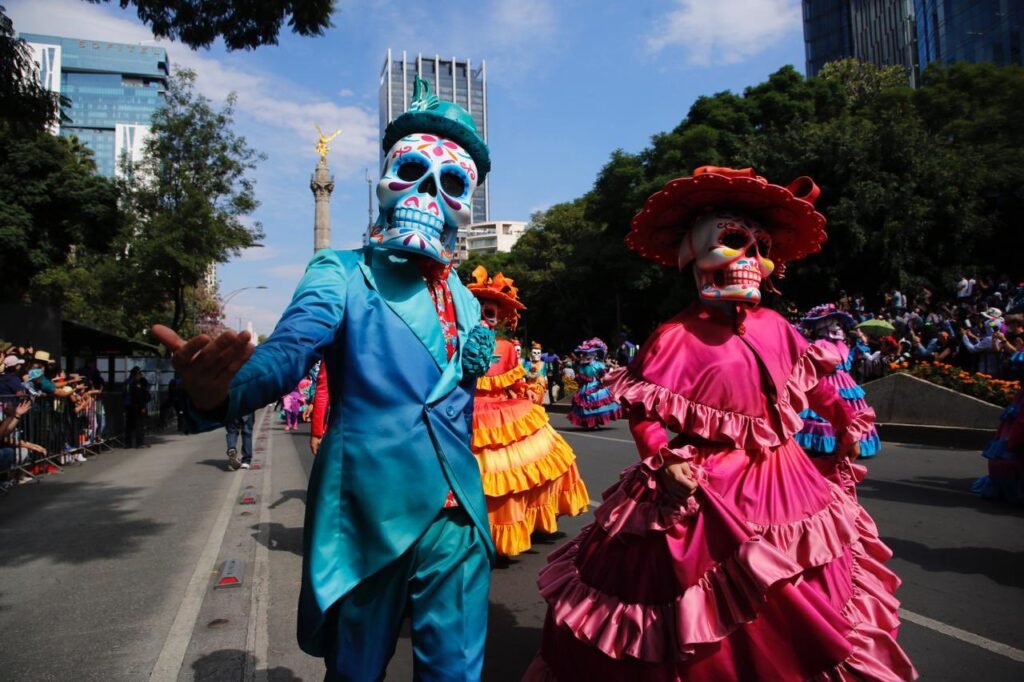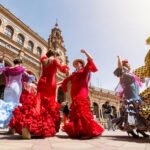Mexico: The Land of Ancient Heritage and Vibrant Culture
Introduction:
Mexico, officially known as the United Mexican States, is a country located in the southern part of North America. It is bordered to the north by the United States, to the south and west by the Pacific Ocean, to the southeast by Guatemala, Belize, and the Caribbean Sea, and to the east by the Gulf of Mexico. The capital city is Mexico City, which is also the largest city and a major cultural, political, and economic center.
Mexico’s geography is diverse, featuring mountains, deserts, and rainforests. The climate varies from temperate in the central highlands to tropical in the coastal and southern regions, providing a rich environment for agriculture, biodiversity, and tourism.
Economically, Mexico is one of the largest economies in Latin America and an important global player. It is known for its industrial base, oil production, and agricultural products. The country uses the Mexican peso (MXN) as its currency. Mexico is renowned for its automotive, electronics, and food industries, with brands like Bimbo, Grupo Modelo, and Pemex being globally recognized.
Culturally, Mexico has a rich heritage that blends indigenous, Spanish, and other influences. Mexican culture is characterized by its contributions to art, literature, music, dance, and cuisine. The country is home to numerous UNESCO World Heritage Sites, reflecting its historical and cultural significance. Spanish is the official language, and Roman Catholicism is the predominant religion.
Mexico’s history is marked by the rise and fall of ancient civilizations, the Spanish conquest, independence in the 19th century, and modern political and social developments. The country’s historical legacy is evident in its ancient ruins, colonial architecture, and cultural traditions.
Politically, Mexico is a federal republic. The President is the head of state and government. Mexico is an influential member of various international organizations, including the United Nations, the Organization of American States, and the G20.
Tourism in Mexico is a major industry, attracting millions of visitors each year to its historical landmarks, stunning beaches, and vibrant cities. Popular destinations include Cancun, Tulum, Mexico City, and the Yucatan Peninsula. Mexico’s culinary traditions, cultural festivals, and natural beauty make it a top destination for travelers.
110 Facts About Mexico (2024)
Basic Information
| Category | Details |
|---|---|
| 1. Current Name | Mexico |
| 2. National Name | Estados Unidos Mexicanos (United Mexican States) |
| 3. Former Names | New Spain |
| 4. Date of Establishment | September 16, 1810 (Independence from Spain) |
| 5. Date of Independence | September 16, 1810 (from Spain) |
| 6. Leadership | President: Andrés Manuel López Obrador |
| 7. Government Type | Federal presidential constitutional republic |
Geography
| Category | Details |
|---|---|
| 8. Capital City | Mexico City |
| 9. Important Cities | Guadalajara, Monterrey, Puebla, Tijuana, Cancun |
| 10. Land Area | 1,964,375 square kilometers |
| 11. Total Area | 1,964,375 square kilometers |
| 12. Neighboring Countries (Land) | United States, Guatemala, Belize |
| 13. Neighboring Countries (Sea) | Cuba |
| 14. UNESCO World Heritage Sites | Chichen Itza, Teotihuacan, Palenque (35 sites) |
| 15. UNESCO World Natural Sites | Monarch Butterfly Biosphere Reserve, Sian Ka’an |
| 16. Climate | Temperate in the central highlands, tropical in the coastal and southern regions |
| 17. Biodiversity | Extremely diverse flora and fauna, including jaguar and monarch butterfly |
| 18. Famous River | Rio Grande |
| 19. Famous Mountain | Popocatépetl |
| 20. Coastline Length | 9,330 kilometers |
| 21. Major Islands | Cozumel, Isla Mujeres |
| 22. Longest River | Rio Grande |
| 23. Highest Waterfall | Basaseachic Falls |
| 24. Largest Lake | Lake Chapala |
| 25. Largest Forest | Lacandon Jungle |
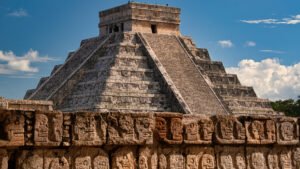
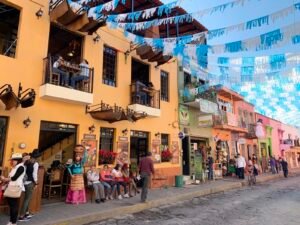
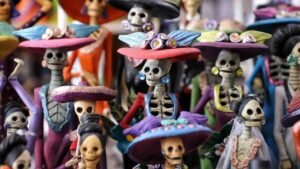
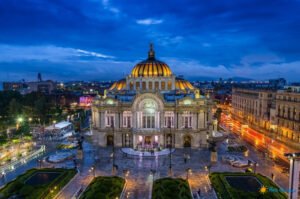

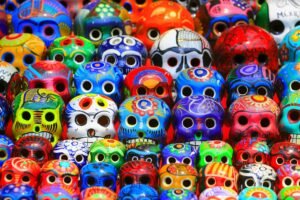
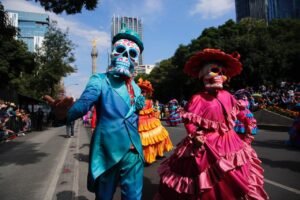

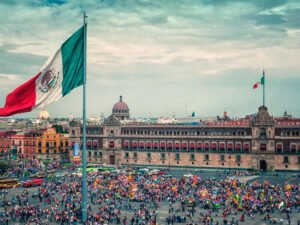
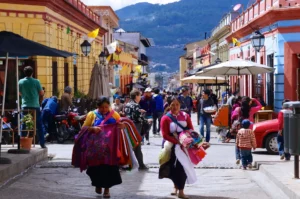
Population
| Category | Details |
|---|---|
| 26. Population (2024) | Approximately 128 million |
| 27. Population (1950) | 27 million |
| 28. Population (1900) | 13.6 million |
| 29. Projected Population (2070) | 150 million |
| 30. Population Density | 65 people per square kilometer |
| 31. Urban Population (%) | 80% |
| 32. Rural Population (%) | 20% |
Demographics
| Category | Details |
|---|---|
| 33. Ethnicity/Race | Mestizo (62%), Indigenous (21%), White (10%), Other (7%) |
| 34. Languages | Spanish (official), 68 indigenous languages |
| 35. National Language | Spanish |
| 36. Religion | Christianity (predominantly Roman Catholic) |
| 37. Median Age | 29.3 years |
| 38. Life Expectancy | 76.7 years |
| 39. Birth Rate | 17.4 births per 1,000 people |
| 40. Death Rate | 5.9 deaths per 1,000 people |
Economic Indicators
| Category | Details |
|---|---|
| 41. Monetary Unit | Mexican Peso (MXN) |
| 42. GDP | $1.3 trillion (2022 est.) |
| 43. GDP per Capita (PPP) | $21,200 (2022 est.) |
| 44. Income Level | Upper-middle income |
| 45. Consumer Price Inflation | 7.8% (2022 est.) |
| 46. Current Account Balance | -$6.7 billion (2022 est.) |
| 47. Exchange Rate (Per $) | 1 USD = 19.85 MXN |
| 48. Unemployment Rate | 4.2% (2022 est.) |
| 49. Stocks Inward ($ billion) | 600 (2022 est.) |
| 50. Real GDP Growth (%) | 3.1% (2022 est.) |
| 51. Labor Force (Million) | 58 million |
| 52. Major Industries | Automotive, electronics, oil, food processing, tourism |
| 53. Major Exports | Vehicles, machinery, electronics, oil, silver |
| 54. Major Imports | Machinery, electrical equipment, vehicles, plastics, oil |
| 55. Public Debt (% of GDP) | 54.7% (2022 est.) |
| 56. Tax Revenue (% of GDP) | 13.1% (2022 est.) |
| 57. Minimum Wage | $172.87 MXN per day |
| 58. Average Household Income | $12,000 per year |
| 59. Inflation Rate | 7.8% (2022) |
| 60. Interest Rate | 4.25% (2022) |
| 61. Major Trade Partners | United States, China, Germany, Canada, Japan |
Social Indicators
| Category | Details |
|---|---|
| 62. Literacy Rate | 95.4% |
| 63. Fertility Rate | 2.1 children per woman |
| 64. Infant Mortality Rate | 12.2 per 1,000 live births |
| 65. Under-5 Mortality Rate | 15.1 per 1,000 live births |
| 66. National Holidays | Independence Day, Day of the Dead, Christmas |
| 67. Health Care System | Universal healthcare system |
| 68. Health Expenditure (% of GDP) | 5.8% (2022 est.) |
| 69. Obesity Rate | 28.9% of adults |
| 70. Drinking Water Source | 96% of the population has access to clean drinking water |
| 71. Access to Sanitation |
| 93% of the population has access to improved sanitation facilities || 72. Average Life Satisfaction | 6.7/10 |
| 73. Major Health Issues | Diabetes, cardiovascular diseases, respiratory infections |
| 74. Smoking Rate | 15.5% of adults |
Culture and Society
| Category | Details |
|---|---|
| 75. Famous People | Frida Kahlo, Diego Rivera, Octavio Paz, Guillermo del Toro |
| 76. Legal Marriage Age | 18 years |
| 77. Gender Inequality Index | 0.334 (2021) |
| 78. National Sport | Soccer |
| 79. Sport Achievements | Olympic medals, FIFA World Cup participation |
| 80. National Animal | Golden eagle |
| 81. National Fruit | Avocado |
| 82. Famous Landmarks | Chichen Itza, Teotihuacan, Palenque |
| 83. National Dish | Mole Poblano |
| 84. Major Newspapers | El Universal, La Jornada, Reforma |
| 85. Major TV Channels | Televisa, TV Azteca, Canal Once |
| 86. Popular Music Genres | Mariachi, ranchera, pop |
| 87. National Theatre | Palacio de Bellas Artes, Mexico City |
| 88. National Gallery | Museo Nacional de Arte, Mexico City |
| 89. Popular Festivals | Day of the Dead, Guelaguetza, Cervantino International Festival |
| 90. Average Internet Speed | 30 Mbps |
| 91. Most Popular TV Show | “El Chavo del Ocho” |
| 92. Most Popular Book | “Like Water for Chocolate” by Laura Esquivel |
| 93. Most Popular Sport | Soccer |
| 94. Most Visited Museum | National Museum of Anthropology, Mexico City |
| 95. Largest Stadium | Estadio Azteca, Mexico City |
| 96. National Anthem | “Himno Nacional Mexicano” |
| 97. Famous Historical Sites | Chichen Itza, Teotihuacan, Palenque |
| 98. Major Brands | Bimbo, Grupo Modelo, Pemex |
| 99. Famous Foods | Tacos, tamales, enchiladas |
| 100. Famous Drinks | Tequila, mezcal, horchata |
Education
| Category | Details |
|---|---|
| 101. Best Public University | National Autonomous University of Mexico (UNAM) |
| 102. Best Private University | Monterrey Institute of Technology and Higher Education (ITESM) |
| 103. Education Rank | 48th globally |
| 104. School Enrollment Rate | 94% for primary education |
| 105. Average Class Size | 25 students |
| 106. Notable Alumni | Carlos Slim, Octavio Paz, Elena Poniatowska |
| 107. Public Spending on Education | 4.5% of GDP |
| 108. Number of Universities | Over 150 |
| 109. Popular Study Abroad Destinations | United States, Spain, Canada |
| 110. Literacy Programs | Extensive adult literacy programs available |
History
Mexico’s history is marked by the rise and fall of ancient civilizations, the Spanish conquest, independence in the 19th century, and modern political and social developments. The country’s historical legacy is evident in its ancient ruins, colonial architecture, and cultural traditions.
The Flag of Mexico
The national flag of Mexico features three vertical bands of green, white, and red, with the national coat of arms in the center of the white band.

- Green: Represents hope and prosperity.
- White: Symbolizes purity and peace.
- Red: Represents the blood of those who fought for independence.
- Coat of Arms: Depicts an eagle holding a serpent in its beak and talon, perched on a prickly pear cactus.
The flag symbolizes Mexico’s rich history, its struggle for independence, and its commitment to unity and national pride.
